Abstract
Reducing transmission traffic delay is one of the most important issues that need to be considered for routing protocols, especially in the case of multimedia applications over vehicular ad hoc networks (VANET). To this end, we propose an extension of the FzGR (fuzzy geographical routing protocol), named MNH-FGR (multi-next-hops fuzzy geographical routing protocol). MNH-FGR is a multipath protocol that gains great extensibility by employing different link metrics and weight functions. To schedule multimedia traffic among multiple heterogeneous links, MNH-FGR integrates the weighted round-robin (WRR) scheduling algorithm, where the link weights, needed for scheduling, are computed using the multi-constrained QoS metric provided by the FzGR. The main goal is to ensure the stability of the network and the continuity of data flow during transmission. Simulation experiments with NS-2 are presented in order to validate our proposal. Additionally, we present a neural network algorithm to analyze and optimize the performance of routing protocols. The results show that MNH-FGR could satisfy critical multimedia applications with high on-time constraints. Also, the DNN model used can provide insights about which features had an impact on protocol performance.
Keywords:
VANET; video transmission; fuzzy logic; multi-path algorithm; WRR algorithm; QoS; QoE; deep neural networks 1. Introduction
In a world of constant change, transport systems are key to achieving sustainable development. However, many challenges may influence this sector, such as consumption of resources, traffic accidents, traffic diversion, and barely being able to ensure an enjoyable driving experience [1,2]. Thus, the improvement of actual systems is a necessity.
The vehicular ad hoc network (VANET) is an interdisciplinary research concern that guarantees the emergence of intelligent transport systems (ITSs) [3,4]. Indeed, VANET-based applications can provide particular and approved resolutions for efficient and innovative future ITSs. These applications cover several services of human road life, such as those allowing road information and advertisements for passengers (i.e., internet access, driver assistance, and automatic parking), and those procuring safety (i.e., security distance and collision avoidance) [5,6].
In a purely ad hoc vehicular environment, vehicles can communicate with each other through vehicle-to-vehicle (V2V) communication [7]. In fact, vehicles are equipped with wireless communication and processing capabilities that lead to the construction of a mobile network as they move along roads [8].
1.1. Background and Motivation
As VANET is a powerful technology with a very high mobility pattern, an uncomplicated and agile mechanism to make a rapid routing decision remains indispensable.
According to the literature, routing protocols based on geographical location are the most interesting when approaching VANET, as is the greedy perimeter stateless routing (GPSR). The latter allows vehicles to acquire accurate movement information from on-board global positioning system (GPS) receivers. The transmitter forwards the data packet to its neighbor with a short distance from the destination. The deal is that only one parameter is taken into account for the transmission decision: the position information.
An enhanced variant of GPSR, called fuzzy geographical routing (FzGR), was proposed in [9]. This variant adopts the concept of fuzzification [10] and employs a set of resources to send packets over the link with the best quality, rather than a distance-based link. This technique provides much better quality of service (QoS) performance.
FzGR gathers two proposed approaches (Figure 1). The first approach computes the score of each one-hop from three QoS measures to support the choice of the optimal next-hop, hence meeting the needs of users. The three quality measures calculated for this purpose are delay, throughput, and the size of the buffer. The second approach uses the relevant score beside the principal metric on which the GPSR is based, i.e., distance between each neighbor and the final destination, in order to comply with the standards of this protocol. The output of each approach is calculated by the fuzzy logic controller (FLC).

Figure 1.
General model: FzGR best next-hop election algorithm [9].
In the context of multimedia data transmission over vehicular networks, the instability and the dynamism of communicating vehicles (nodes) impacts significantly the quality of the video during the transmission [11,12]. The FzGR protocol improves the streaming quality, either in terms of quality of service (QoS) or quality of experiment (QoE). However, the transmission delay must be further enhanced while keeping good performance.
Alternatively, where neighboring nodes along a path may move out of transmission range, the stability along the path in the existence of expiring links must be considered. Another major reason for a connection to break down is when an intermediate node or destination node becomes inaccessible. This is due to multiple factors, like node failure or when a node becomes unresponsive.
To this end, a new form of routing protocol has taken strides in this area: multipath routing protocols [13,14]. In fact, their implementation in VANET aims to improve several criteria, namely load-balancing, reliability, fault tolerance, security, and QoS.
1.2. Paper Contribution
In this paper, we propose an extension of the FzGR protocol, called multi-next-hop fuzzy geographical routing (MNH-FGR). Like FzGR, the MNH-FGR protocol uses the fuzzy algorithm, but considers a limited number of neighboring nodes able to ensure a good routing of the data. The objective is to select, dynamically, a set of links with less or equal weight to a predefined threshold. This approach will make it possible to send the data packets to several neighbors instead of a single one. Our multi-next-hops approach, which respects the load balancing, aims to promote the quality of video transmission by further improving the rate of packet delivery and especially by minimizing the end-to-end delay in order to achieve a good perception from the user regarding the final content received. The main contribution of this paper can be summarized as follows: our MNH-FGR variant inherits from the FzGR protocol all the fuzzy characteristics, making it a perfect fit for vehicle-critical environments. In addition, it integrates the weighted round-robin (WRR) scheduling algorithm to balance the multiple selected links with different QoS.
1.3. Paper Organization
The rest of this article is organized into six main sections. In Section 2, we review some existing approaches related to multipath routing strategies and to the use of artificial intelligence in this area. In Section 3, we describe the new approach, its materials, and used methods. In Section 4, we provide the simulation parameters, results, and discussions. In Section 5, we discuss the use of deep neural networks (DNNs) to analyze and optimize the performance of routing protocols. Finally, in Section 6, we conclude the paper and provide some eventual perspectives.
2. Related Works
In this section, we present a comprehensive review of the existing approaches related to multipath routing strategies and the utilization of artificial intelligence in wireless networks, with a focus on vehicular ad hoc networks (VANETs) and multimedia data transmission.
2.1. Multipath Routing Strategies in Wireless Networks
In order to maintain a high degree of connectivity and ensure a good quality of service (QoS), several algorithms have been developed by researchers in the field of wireless networks. These algorithms are based on the idea of exploiting all nodes of the topology to ensure the continuity of the data flow. Whether for a vehicular ad hoc network (VANET), mobile ad hoc network (MANET), or even for a wireless sensor network (WSN), the multi-path approach has shown great promise [15,16]. Indeed, various existing routing protocols have improved their performance by taking into account effective multi-path strategies.
The GBR protocol (greedy-based backup routing protocol) was proposed by the authors of [17]. It is a greedy-based backup protocol designed specifically for MANET networks [18]. GBR considers both the length of the route and the lifetime of the link to achieve high road stability. The main path is built primarily from a greedy transfer mechanism, while the local backup path for each link is established according to their lifetime. GBR shows great performance in terms of route lifetime, packet delivery ratio, and control overhead. However, it may face challenges related to QoS and load balance. To guarantee multimedia transmission in a highly dynamic VANET topology, our proposed protocol deals with mobility, the breakdown of wireless links, node disappearances and reappearances, QoS, and load balance.
The MP-OLSR protocol (multipath OLSR) was also developed for MANET networks by the authors of [19]. It represents an improved multi-path variant of the OLSR standard and focuses on optimizing the quality of data transmission by improving the rate of packet delivery and load balancing. However, the protocol’s limitation is its reliance on the number of hops as the sole measure for routing decisions, which hinders its ability to find the best path in terms of QoS, especially for VANET scenarios [20].
In addition to MANETs, the authors of [21] introduced the AGEM protocol (adaptive greedy compass energy-aware multipath routing protocol) for wireless sensor networks (WSNs). AGEM utilizes a pure greedy routing protocol, like GPSR, where the data flow always uses the same route. In contrast, AGEM dynamically routes the data flow through different paths to meet the constraints of multimedia transmission and maximize network lifetime. To achieve this, AGEM employs the online multi-channel capability of the WSN to balance the load between nodes using a suitable COMPASS transfer model [22]. However, AGEM may not be experienced with realistic streams that model multimedia transmissions.
The authors of [23] proposed junction-based multipath source routing (JMSR) for VANET networks. While multipath is beneficial for VANETs, JMSR considers only two paths to the destination, which may not be enough to satisfy QoS requirements. A recovery mechanism to cover cases where no suitable forwarding nodes have been found must be considered [24].
In [25], the FQ-MP-OLSR protocol was proposed as an extension of MP-OLSR to achieve acceptable QoS and QoE for video transmission over MANETs. While FQ-MP-OLSR shows promising results, it can still be improved, particularly by reducing topology control traffic [26].
In the context of WSNs, the CSA-MGR protocol [27] creates multiple paths while avoiding shared detection areas through a distributed and dynamic process. However, it lacks consideration of simulations in large-scale situations and with mobility cases, like in VANET environments, as well as realistic stream-modeling multimedia transmissions.
Addressing VANETs, the EMPAODV (enhanced multipath AODV) [28] protocol adopts a multi-path strategy based on the expected lifetime of links to guarantee better performance. Varying the lifetime of paths and the hello interval, EMPAODV reduces the end-to-end delay and packet–loss ratio. However, it may still face challenges related to QoS and adaptability in highly dynamic scenarios.
Numerous techniques and methodologies have been proposed in the literature to improve the performance of GPSR (greedy perimeter stateless routing) in vehicular environments. For instance, the MAGF [29] protocol introduced the concept of “motion potential” to enable intelligent forwarding decisions [30] and DGF-ETX for VANET [31] proposed an enhanced directional greedy forwarding protocol. However, these protocols do not fully address the dynamic nature of VANETs and lack additional QoS information for real-time routing decisions [32].
In the work of Yang et al. [33], the MM-GPSR protocol was proposed utilizing pre-defined λ parameters in the greedy forwarding mechanism. Although this provides some control over the communication area, it may limit the scheme’s performance in dynamic and unpredictable vehicular environments [34]. Additionally, the UF-GPSR [35] protocol addresses routing challenges in flying ad hoc networks (FANETs), but still lacks a comprehensive consideration of parameters relevant to multimedia data transmission.
In the same context, other improvements of the GPSR protocol were developed and then implemented in the calculation of the next-best hop. The goal is to exploit other links in the topology that can improve the QoS of the network. The first one is GPSR-2P [36], which takes into consideration the two nearest neighbors to the destination instead of one, and the second one is GPSR-kP [37], which adopts the concept of multiple paths. GPSR-kP makes it possible to use a number k, limited between 1 and 6, of neighbors near to the destination and is able to transfer the number k of packets owned by the same source node. The destination of packets is taken into account during the decision. Admittedly, these protocols have shown good results compared with those of GPSR, except that they remain unsatisfactory regarding the requirements of the VANET networks on one side and the multimedia flow on the other side. Indeed, GPSR-2P and GPSR-kP do not consider additional QoS information in order to make real-time routing decisions. On the other hand, they use a static number of hops contrary to our proposal.
Despite efforts to improve QoS in VANETs through modifications like GPSR-2P and GPSR-kP, they remain unsatisfactory in meeting both VANET network requirements and multimedia flow needs. These protocols do not effectively consider additional QoS information for real-time routing decisions and use a static number of hops, which can be limiting.
To overcome these limitations and achieve better QoS for multimedia data transmission in VANETs, the proposed intelligent MNH-FGR protocol dynamically adjusts the number of hops based on the network conditions and additional QoS information. By optimizing the data transmission process and enhancing overall network performance under varying conditions, MNH-FGR is well-suited for real-time multimedia applications in VANETs. The adaptive approach aims to promote user gratification and keep a good QoS while avoiding performance degradation caused by transmitting a large number of packets to the same path. Through its dynamic hop adjustment, the MNH-FGR protocol introduces a significant improvement over existing approaches in meeting the QoS requirements of VANETs and multimedia flows.
2.2. Utilization of Artificial Intelligence in Wireless Networks
The use of artificial intelligence (AI) has shown great advantages in the field of wireless networks. Neural networks can be used to predict the performance and the quality of signal transmission between nodes in a wireless network [38]. Machine learning is also used to improve real-time decision-making in routing protocols, such as selecting the best paths for data transmission taking into account network load [39]. The integration of AI in wireless networks allows the optimization of bandwidth and the improvement of quality of service and security, as demonstrated by the study of Sustain [40], which presented a new optimization algorithm machine learning to improve QoS in hybrid wireless networks while preventing malware and routing attacks. Tadilo et al. [41] also presented AI techniques integrating natural language processing (NLP) to improve the efficiency of wireless networks.
Furthermore, integrating AI into vehicular ad hoc networks can also help to reduce energy consumption. Pujol–Roig [42] applied deep reinforcement learning to reduce power consumption at the base station in wireless networks. This algorithm allows cells that overlap in geographic areas to be put into sleep mode based on changing network conditions using cell on/off in dense wireless networks as a Markov decision process. Ultimately, the integration of AI into wireless networks is expected to significantly improve performance and reliability in this area.
3. Materials and Methods
In this section, we discuss the improvement steps of FzGR. In fact, the improvement took place in two stages. The first one implements the multi-next-hop approach, while the second one aims to balance the load between the different selected links.
3.1. Multi-Next-Hops Approach Proposed for FzGR
To avoid congestion and to improve the delay of transmission, we asked ourselves whether it was possible to strike a balance between a large number of packets and a set of effective neighbors. In fact, the intelligent routing protocol MNH-FGR elects dynamically the interesting next-hops (next neighbors) according to the state of the network, as depicted in Figure 2. Thus, the sender can select a single hop, two hops, three hops, etc., without exceeding the maximum threshold assigned to the weight of the link. This threshold is expressed by Equation (1):
where the choice of 20% is justified by the simulation.
Threshold = MinWeight + 20%MinWeight
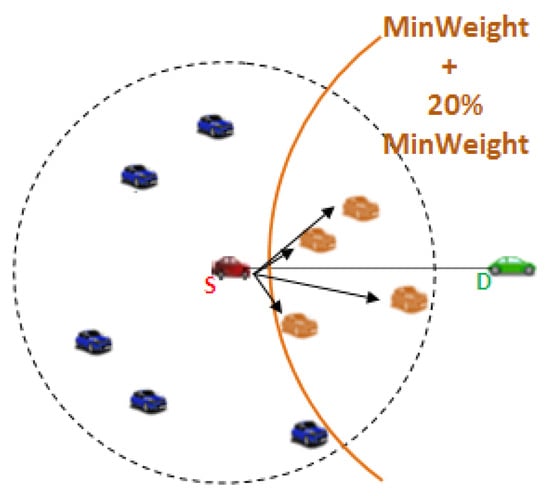
Figure 2.
Adaptive GRS policy for MNH-FGR.
3.1.1. Main Factors on Which MNH-FGR Is Based
Alternative routes: The multimedia traffic should be delivered satisfying the transmission delay and delay requirements. In typical routing protocols, the nearest neighbor leading to the shortest path is heavily used, while other effective neighbors leading to alternate paths are unworkable. This is the case for GPSR and FzGR protocols, where neighbors that are able to meet the requirements of VANET networks are ignored. Sending capacity: A media stream is usually composed of large packets. Therefore, if only one channel is used to route these packets, the transmission requirements may be several times greater than the maximum transmission capacity of the nodes.
Real-time decision: Since the topology can change at any time in an unpredictable way, it is safer to make routing decisions in a distributed and real-time manner. This will make it possible to react in advance to changes in topology and to avoid the transmission of packets to unavailable or unreliable nodes.
Node selection: In highly deployed networks, different neighbors can be selected as candidates to transfer packets. To deduce an appropriate selection, the node selection process must take into account the distance of each neighbor from the final destination, the weight of the different links, and the predefined threshold of the weight that should not be exceeded.
Load balancing: To maximize the uptime of VANETs and, therefore, minimize link failures, load balancing must be considered when designing a multi-hop routing protocol.
We describe, in the following, the load-balancing process implemented in our algorithm.
3.1.2. Load Balancing Approach
The main role of load distribution is to use the elected paths for transporting packets from the source to the destination in a balanced way. By applying the multi-next-hop algorithm to the FzGR protocol, as illustrated in Figure 3, the packets are distributed to several direct links, i.e., direct neighbors of each sending node, so the process is repeated for each participating node until the destination final is reached. In order to balance the load between these different links, we propose to integrate the WRR weighted round-robin [43] scheduling mechanism into MNH-FGR to support multiple heterogeneous links. Indeed, this algorithm requires additional information for the selection. This information was derived from the fuzzy logic applied in FzGR. In addition, WRR is able to balance the load between several heterogeneous links. Thus, if the weights of the bonds are different, WRR can avoid the overuse of the high-weight bonds and the underutilization of the low-weight bonds.
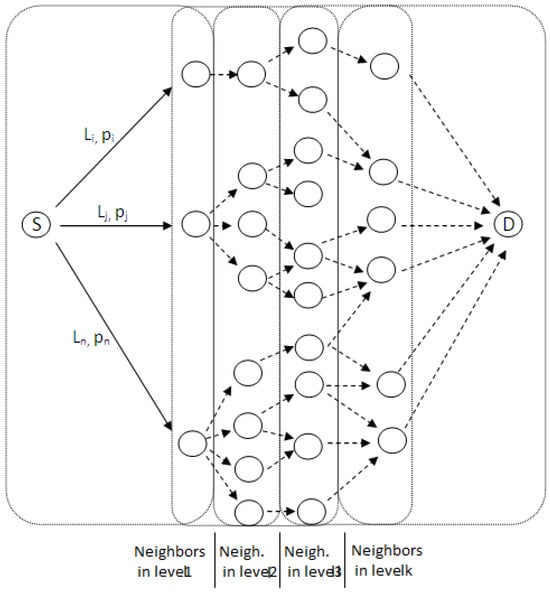
Figure 3.
n weighted links between each sending node and its direct neighbors from the source S to the destination D.
Recalling that a path is composed of several hops, each hop represents only the link between the sender and its immediate neighbor. In addition, each link is affected by a weight that represents an integer value indicating its QoS capability. In our diagram, we calculate the pi weight of Li by the fuzzy approach presented in [9].
The algorithm returns multiple and weighted links. In this case, the links with lower weights could carry a larger number of packages than those with a high weight. In other words, the number of packets allocated to links is limited by the weights of these links. The traffic load distribution, based on the WRR principle (see Algorithm 1), is performed by each sending node in order to distribute the packets in the n paths to the destination node D as a function of the parameter weight pi.
| Algorithm 1. Intelligent Multi-Next-Hop Algorithm of MNH-FGR |
| l_bN ←∅; //Best neighbors set within the range of the sender node |
| cst ← 20%; //constant |
| Function mpNexthop(destx, desty) |
| nexthop ← Null; |
| if (l_bN is empty) |
| createListBN(destx, desty); |
| end if |
| if (l_bN is not empty) |
| nexthop ← l_bN(0); //assign to nexthop the first item on the list |
| l_bN.remove(0); //remove the first item from the list |
| l_bN.pushback(nexthop);//add it at the end of the same list |
| end if |
| return nexthop; |
| End Function |
| Procedure createListBN(destx,desty) |
| l ← [nr1, nr2, nr3, …, nri] ε Range(SenderNode); |
| nexthop; |
| score, thresholdScore; |
| if (l_bN is not empty) |
| l_bN ←∅; |
| end if |
| minScore ← Infinity; |
| While (l is not empty) |
| nexthop = fuzzyNextHop(destx,desty,l); |
| if (nexthop = null) |
| exit while; |
| end if |
| score ← getScore(nexthop,destx,desty); |
| if (score < minScore) |
| minScore ← score; |
| thresholdScore ← minScore ∗ (1 + cst); |
| else if (thresholdScore < score) |
| exit while; |
| end if |
| end if |
| l.removeElement(nexthop); //remove nexthop from the list of neighbors |
| l_bN.pushback(nexthop); //add it to the list of best neighbors |
| end while |
| End Procedure |
| Function fuzzyNexthop(destx,desty,l) //here, l is the list of neighbors |
| //that belong to the range of the sender node |
| minScore ← getscore(nr1,destx,desty); |
| nexthop ← nr1; |
| For each l |
| score ← getscore(nri, destx, desty); |
| if (score < minScore) |
| minScore ← score; |
| nexthop ← nri; |
| End if |
| End for |
| return nexthop; |
| End Function |
3.2. Type of Multi-Next-Hops Selection
The multi-next-hop approach can take various forms depending on the relevance of the participating node (Figure 4): (i) disjoint nodes, (ii) disjoint links, and (iii) non-disjoint nodes or links [44].
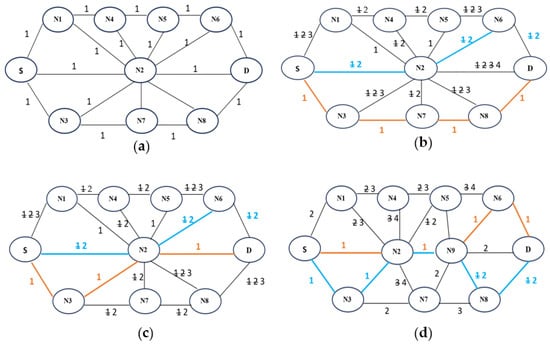
Figure 4.
Illustration of the three types of hop selection according to the weight of the links; (a) initial graph, (b) with disjoint nodes, (c) with disjoint links, and (d) with non-disjoint nodes or links.
3.2.1. Disjoint Nodes
Multi-link routing can result in paths whose nodes are disjointed. This case is known by a “link-less” routing, since no link is shared between the nodes or between the existing paths. An example of this category is shown in Figure 4b. Indeed, the routes between the source node S and the destination node D (S-N2-N6-D and S-N3-N7-N8-D) are disjointed routes.
3.2.2. Disjoint Links
A disjoint path refers to the fact that the link is not shared between the different paths, but may have common nodes. As shown in Figure 4c, the two paths between the source node S and the destination node D (S-N2-N6-D and S-N3-N2-D) are disjoint paths, where node N2 is the common node.
3.2.3. Disjoint Nodes/Links
Multi-link routing can also lead to non-disjoint multiple paths. These are paths that have shared nodes and common links. Figure 4d clearly illustrates this case. Indeed, (S-N2-N9-N6-D and S-N3-N2-N9-N8-D) are non-disjoint paths, with N2-N9 representing the common link.
4. Performance Evaluation
4.1. Simulation Parameters
We opted for the Nakagami radio propagation model, which takes into account obstacles, to better reflect reality. We also used a real map to validate our contribution. In fact, owing to the VanetMobiSim tool, we imported maps from the US Census TIGER/Line database, which includes full coverage of the US, Puerto Rico, and many other cities. For our simulations, we considered a downtown-type traffic called TGR11001 that represents the District of Columbia, Washington [45]. The deployment of the vehicles is established by the intelligent lane-change pilot model (IDM LC), which makes the simulation in the network layer reliable.
Figure 5 represents the used urban environment. The set of simulation parameters are given in Table 1.
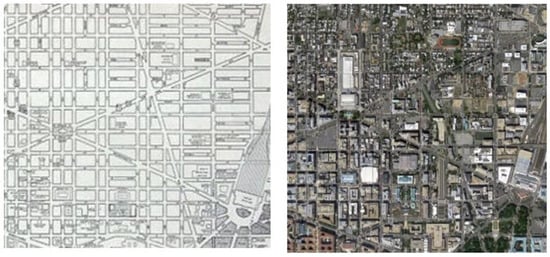
Figure 5.
District of Columbia, Washington.

Table 1.
Simulation parameters.
4.2. Results and Discussion
4.2.1. QoS Measurements as a Function of Network Density
QoS (quality of service) measurements are important in the evaluation of wireless networks; they provide valuable information about network performance and quality. One of the significant aspects of QoS measurement is network density, which directly affects the quality of a service provided [46]. In this context, this section presents QoS measurements as a function of network density. The metrics used to measure QoS are packet delivery rate (PDR), throughput, overhead, and end-to-end delay.
For further details, the mathematical equations of QoS and QoE metrics can be found in [47].
- a.
- PDR Measurement
Figure 6a illustrates the delivered packet rate (PDR) for different density cases. It can be seen that, for all density variations, the result of the PDR using the MNH-FGR protocol is more significant compared with the results provided by the two GPSR multi-path variants, i.e., GPSR-2P and GPSR-kP, as well as by the fuzzy variant FzGR. Looking at Table 2 and Table 3, we notice that MNH-FGR can increase the rate of delivered packets up to 9.63%, 26.61%, and 47.35% over, respectively, FzGR, GPSR-2P, and GPSR-kP. The degradation achieved by the GPSR-2P and GPSR-kP protocols is justified by the use of dij as a single measure in the routing decision. This metric cannot avoid unstable links that can cause breakage due to congestion or outdated neighbors. However, MNH-FGR adopts a clever routing decision process that allows it to select a set of better and more stable next hops in a dynamic way, regarding QoS.
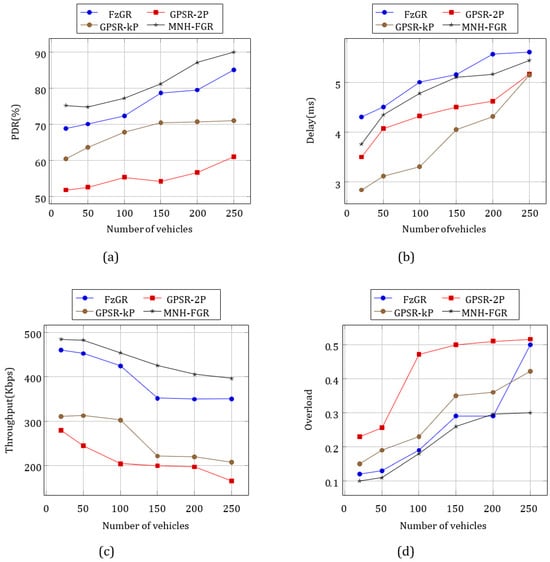
Figure 6.
QoS measurements as a function of density: (a) PDR, (b) delay, (c) throughput, and (d) overload.

Table 2.
MNH-FGR’s QoS improvement rate regarding GPSR-kP for all different density scenarios.

Table 3.
MNH-FGR’s maximal QoS improvement rate regarding FzGR, GPSR-2P, and GPSR-kP.
- b.
- End-to-End Delay Measurement
Figure 6b demonstrates that the transmission delay for MNH-FGR increases for almost all density scenarios. This degradation is explained by the fact that the multi-next-hop variant takes more time to calculate the real-time link quality in order to select the most optimal ones. The MNH-FGR protocol helped to increase the end-to-end delay up to 6 ms, but it remained insufficient compared with the threshold, which must not exceed the value of 150 ms in the case of video streams [48]. In other words, there is a degradation, but it does not influence the quality of the video received. Nevertheless, we managed to reduce the delay compared with the FzGR protocol up to 9.74%, which approves the effectiveness of our approach.
- c.
- Throughput Measurement
Figure 6c illustrates the throughput for different density scenarios. It can be noted that, regardless of the number of vehicles, the flow rate using the MNH-FGR was higher than that when we used the other protocols. Thus, according to Table 2 and Table 3, MNH-FGR increases the rate up to 35.55%, 47.07%, and 73.26% over, respectively, FzGR, GPSR-2P, and GPSR-kP. This is normal, since the number of delivered packets is high at each step of GPSR improvement.
- d.
- Overload Measurement
Our improvements also reduced the load on routing. Indeed, Figure 6d clearly shows the values of this metric. It can be seen that the routing load was significantly lower for MNH-FGR. Indeed, MNH-FGR uses the WRR packet-scheduling algorithm to balance the transmission of packets between the different links. The weights of these links, used by the WRR algorithm, are calculated by the fuzzy system as a function of the QoS multi-constraint metric. In fact, as the PDR increases, the route load decreases, since it represents the total of all the packets shared out of the total video packets received. Also, our proposal provides connectivity between the sender and the receiver, so there is not a lot of retransmissions. As shown by Table 2 and Table 3, MNH-FGR can reduce the route load up to 11.76%, 42.11%, and 61.7% over, respectively, FzGR, GPSR-2P, and GPSR-kP.
4.2.2. QoE Measurements
Video streaming is one of the defiant issues in VANETs due to their exception topology and connectivity disruptions. Our contribution aims to improve the quality of experience (QoE) of the received video. Thus, QoE metrics, as a function of network density, are crucial metrics to consider when evaluating the performance of different routing protocols [36,49]. Figure 7 compares the video quality of Foreman, perceived by the user, for each used routing protocol, including FzGR, GPSR-2P, GPSR-kP, and MNH-FGR. We notice that MNH-FGR provided better values compared with other protocols. Thus, as summarized in Table 4, MNH-FGR increased the PSNR and SSIM parameters, respectively, up to 25.30% and 29.62% compared with GPSRkP. We also notice that the VQM parameter was reduced by 42.88%.
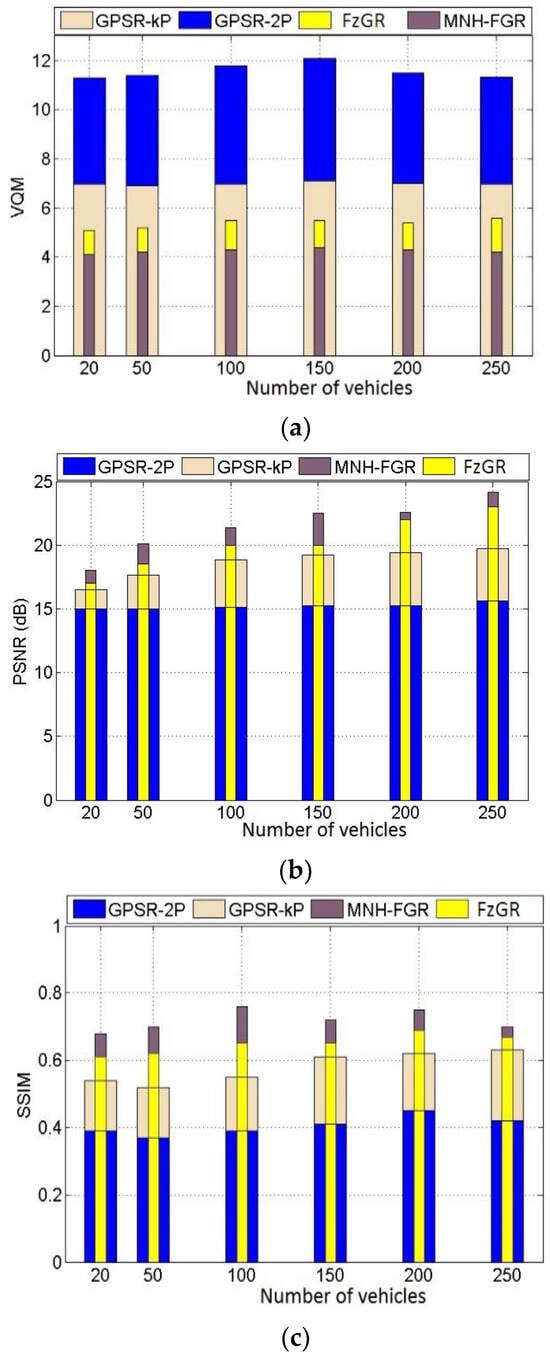
Figure 7.
QoE measurements as a function of density: (a) VQM, (b) PSNR, and (c) SSIM.

Table 4.
MNH-FGR’s QoE improvement rate regarding GPSR-kP for all different density scenarios.
In addition, it is especially necessary to mark the improvement rate of our new variant compared with our first contribution. Indeed, according to Table 5, the MNH-FGR protocol can increase the signal noise rate, as well as the structural similarity index, respectively, up to 12.5% and 23.81% compared with FzGR. The video quality metric, meanwhile, is reduced by 31.03%.

Table 5.
MNH-FGR’s maximal QoE improvement rate regarding FzGR, GPSR-2P, and GPSR-kP.
In short, the results presented in this last part about QoE demonstrate the superiority of the MNH-FGR routing protocol over the other protocols tested in terms of improving the video quality perceived by users. The improvement rate of MNH-FGR compared with FzGR, GPSR-2P, and GPSR-kP was significant in all scenarios tested. These findings are particularly relevant for researchers and engineers in the field of wireless sensor networks who want to optimize the performance of their routing protocols and ensure high QoE for users. The MNH-FGR protocol provides a promising solution for improving the QoE of multimedia applications in WSNs, and further research can focus on exploring its potential in more complex scenarios.
5. Neural Network for Analyzing and Optimizing the Performance of Routing Protocols
Deep neural networks (DNNs) are a type of artificial neural network that have several hidden layers between input and output. These layers allow the network to learn increasingly complex features and patterns in the input data, which can be used to make accurate predictions or classifications [50].
The objective here is to use a deep neural network model to analyze and optimize routing protocols in wireless networks. This involves training a deep learning model on a dataset, the “MANIAC Dataset” [51]. The MANIAC Challenge dataset consists of routing parameters that were collected during the MANIAC (Mobile Ad hoc Networking Interoperability and Collaboration) Challenge. This dataset captures real-world network scenarios and provides valuable insights into the performance and behavior of routing protocols in dynamic wireless environments; this dataset consists of network simulations and metrics, such as packet loss, latency, throughput, and power consumption, as well as protocol-specific parameters, such as hop count, link quality, and table size. The specific objectives are as follows:
- Analysis: The trained model was used to analyze the dataset, identifying patterns and relationships between input characteristics (metrics and parameters mentioned in this study) and routing protocol performance;
- Optimization: Based on learned patterns and relationships, the DNN model can predict the optimal routing protocol for new network scenarios. By leveraging the knowledge gained from the data set, the model can make accurate predictions regarding the most appropriate routing protocol for a given scenario, thereby improving overall network performance and efficiency;
- Feature importance: The model also helps to understand which features have the greatest impact on protocol performance. By interpreting DNN results, researchers and network engineers can better understand the underlying mechanisms of different routing protocols, identifying the key factors that influence their performance.
To provide a clearer understanding of our methodology, we have included pseudo code (Algorithm 2) that outlines the steps for using the DNN to analyze and optimize routing protocols for wireless networks. The code covers various stages, including dataset loading, model architecture definition, model training and evaluation, predicting optimal routing protocols for new scenarios, and interpreting the DNN results.
| Algorithm 2. Analyze and optimize routing protocols |
| # Loading dataset |
| X_train, y_train, X_test, y_test = load_network_dataset() |
| # architecture |
| model = Sequential() |
| model.add(Dense(128, activation = ‘relu’, input_dim = X_train.shape [1])) |
| model.add(Dense(64, activation = ‘relu’)) |
| model.add(Dense(32, activation = ‘relu’)) |
| model.add(Dense(1, activation = ‘sigmoid’)) |
| model.compile(optimizer = ‘adam’, loss = ‘binary_crossentropy’, metrics = [‘accuracy’]) |
| # Training the model |
| model.fit(X_train, y_train,epochs = 100,batch_size = 32,validation_data = (X_test, y_test)) |
| # Testing the model |
| test_loss, test_acc = model.evaluate(X_test, y_test) |
| # Predicting the optimal routing protocol for new network scenarios |
| X_new = generate_network_scenario() |
| optimal_protocol = model.predict(X_new) |
| # Interpreting DNN results |
| feature_importances = get_feature_importances(model, X_train) |
DNN Results
We trained a deep neural network (DNN) model on a dataset of network simulations, consisting of various features and parameters related to routing protocols for wireless networks. The dataset contained 10,000 data points, with 70% of the data used for training, 15% for validation, and 15% for testing. We used a DNN architecture with three hidden layers, each with 256 neurons, and a final output layer with three nodes representing the three routing protocols under consideration. The model was trained using the Adam optimization algorithm with a learning rate of 0.001 for a total of 100 epochs. As shown in Figure 8, after training, the DNN model achieved an accuracy of 87% on the test set, indicating that it can predict the optimal routing protocol with a high degree of accuracy for a given network scenario.
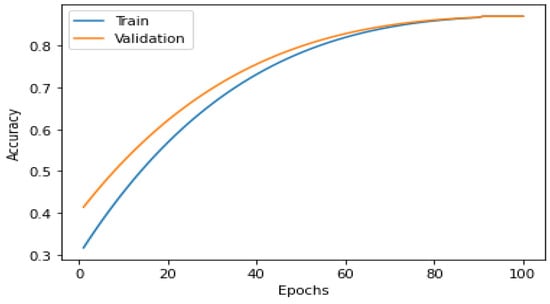
Figure 8.
Training and Validation Accuracy of DNN Model.
The results of the training and validation of the DNN model demonstrate that this model can be used to accurately predict the optimal routing protocol, based on a set of input features and parameters. The high accuracy of our model suggests that there are discernible patterns and relationships between the input features and protocol performance, and that these can be learned by a deep neural network.
As Figure 9 shows, the DNN model also provided insights into which features had the greatest impact on protocol performance. Specifically, we found that link quality, hop count, and routing table size were the most important features for predicting protocol performance, while metrics such as packet loss and latency had a smaller impact. These findings can be useful for network engineers and researchers in selecting the most appropriate protocol for a given network scenario and for optimizing network performance based on the most important features.
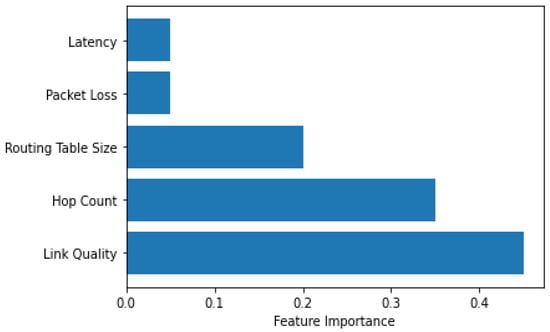
Figure 9.
Impact of Features on Protocol Performance.
This section of the study, which concerns the use of the DNN model, is limited by the specific dataset used for training, which may not fully capture the complexity and diversity of real-world network scenarios. Future studies should consider using larger and more diverse datasets and explore alternative DNN architectures and optimization algorithms. Nevertheless, our results demonstrate the potential of deep learning to analyze and optimize routing protocols for wireless networks, and provide a promising direction for future research in this area.
6. Conclusions
In this paper, we introduce MNH-FGR, an enhanced variant of the FzGR protocol, with the objective of achieving satisfactory Quality of Service (QoS) and Quality of Experience (QoE) for video transmission in VANET networks. Our approach incorporates a multi-hop strategy into the existing fuzzy system of FzGR, allowing for the dynamic utilization of the network topology. The link weights needed for packet scheduling represent the multi-constrained QoS metrics extracted by the fuzzy system. The MNH-FGR routing protocol has been successful in improving the QoS and QoE of video transmission compared with the GPSR-2P and GPSR-kP protocols that use the classic greedy mechanism, but also those with respect to fuzzy protocol FzGR. The proposed technique is consistent with the requirements of revocability, diversity, and security.
While this proposed approach has shown effective results, there are limitations that require further research to address. One major limitation is that the effectiveness of the proposed method highly depends on the accuracy of link quality metrics, which can be difficult to achieve in some scenarios and may lead to suboptimal routing decisions. Addressing these limitations is one of the main perspectives of our research. We also presented the results of our DNN model, which achieved an accuracy of 87% in predicting the optimal routing protocol based on a set of features and input parameters. These results show the potential of artificial intelligence in the analysis and optimization of routing protocols for wireless networks, providing a promising direction for future research in this area.
However, there was a delay degradation observed for the MNH-FGR protocol. This degradation was due to the fact that the multi-next-hop variant took a little longer time to calculate the quality of the links in real time in order to select the most optimal ones. In perspective, the improvement of MNH-FGR should be continued in terms of delay, and this protocol should be applied for FANET networks (Flying Ad Hoc Networks).
Author Contributions
Conceptualization, I.Z.; Methodology, I.Z. and M.O.; Validation, A.B. and M.O.; Writing—original draft, I.Z.; Writing—review & editing, I.Z. and B.J.; Visualization, B.J., M.H.A. and A.E.M.; Supervision, M.O.; Project administration, I.Z. All authors have read and agreed to the published version of the manuscript.
Funding
This research received no external funding.
Data Availability Statement
All data has present in main text.
Conflicts of Interest
The authors declare no conflict of interest.
References
- Houssaini, Z.S.; Zaimi, I.; Drissi, M.; Oumsis, M.; Ouatik, S.E.A. Trade-off between Accuracy, Cost, and QoS Using a Beacon-on-Demand Strategy and Kalman Filtering over a VANET. Digit. Commun. Netw. 2018, 4, 13–26. [Google Scholar] [CrossRef]
- Musa, A.A.; Malami, S.I.; Alanazi, F.; Ounaies, W.; Alshammari, M.; Haruna, S.I. Sustainable Traffic Management for Smart Cities Using Internet-of-Things-Oriented Intelligent Transportation Systems (ITS): Challenges and Recommendations. Sustainability 2023, 15, 9859. [Google Scholar] [CrossRef]
- Pereira, R.; Boukerche, A.; Da Silva, M.A.C.; Nakamura, L.H.V.; Freitas, H.; Rocha Filho, G.P.; Meneguette, R.I. FORESAM—FOG Paradigm-Based Resource Allocation Mechanism for Vehicular Clouds. Sensors 2021, 21, 5028. [Google Scholar] [CrossRef] [PubMed]
- Quessada, M.S.; Pereira, R.S.; Revejes, W.; Sartori, B.; Gottsfritz, E.N.; Lieira, D.D.; Da Silva, M.A.; Rocha Filho, G.P.; Meneguette, R.I. ITSMEI: An Intelligent Transport System for Monitoring Traffic and Event Information. Int. J. Distrib. Sens. Netw. 2020, 16, 155014772096375. [Google Scholar] [CrossRef]
- Naseer, K. Localization-Based System Challenges in Vehicular Ad Hoc Networks: Survey. Smart Comput. Rev. 2014, 4, 515–528. [Google Scholar] [CrossRef]
- Zaimi, I.; Houssaini, Z.S.; Boushaba, A.; Oumsis, M. An Improved GPSR Protocol to Enhance the Video Quality Transmission over Vehicular Ad Hoc Networks. In Proceedings of the 2016 International Conference on Wireless Networks and Mobile Communications (WINCOM), Fez, Morocco, 26–29 October 2016; pp. 146–153. [Google Scholar]
- Brennand, C.A.R.L.; Filho, G.P.R.; Maia, G.; Cunha, F.; Guidoni, D.L.; Villas, L.A. Towards a Fog-Enabled Intelligent Transportation System to Reduce Traffic Jam. Sensors 2019, 19, 3916. [Google Scholar] [CrossRef]
- Meneguette, R.I.; Filho, G.P.R.; Guidoni, D.L.; Pessin, G.; Villas, L.A.; Ueyama, J. Increasing Intelligence in Inter-Vehicle Communications to Reduce Traffic Congestions: Experiments in Urban and Highway Environments. PLoS ONE 2016, 11, e0159110. [Google Scholar] [CrossRef]
- Zaimi, I.; Boushaba, A.; Squalli Houssaini, Z.; Oumsis, M. A Fuzzy Geographical Routing Approach to Support Real-Time Multimedia Transmission for Vehicular Ad Hoc Networks. Wirel. Netw. 2019, 25, 1289–1311. [Google Scholar] [CrossRef]
- Zadeh, L.A. Fuzzy Logic. Computer 1988, 21, 83–93. [Google Scholar] [CrossRef]
- Joshua, C.J.; Jayachandran, P.; Md, A.Q.; Sivaraman, A.K.; Tee, K.F. Clustering, Routing, Scheduling, and Challenges in Bio-Inspired Parameter Tuning of Vehicular Ad Hoc Networks for Environmental Sustainability. Sustainability 2023, 15, 4767. [Google Scholar] [CrossRef]
- Alkhodair, A.; Mohanty, S.P.; Kougianos, E. FlexiChain 3.0: Distributed Ledger Technology-Based Intelligent Transportation for Vehicular Digital Asset Exchange in Smart Cities. Sensors 2023, 23, 4114. [Google Scholar] [CrossRef]
- Jalade, S.C.; Patil, N.B. Adaptive Deep Runge Kutta Garson’s Network with Node Disjoint Local Repair Protocol Based Multipath Routing in MANET. Evol. Syst. 2023, 1–25. [Google Scholar] [CrossRef]
- Lu, Y.; Chen, Y.; Xu, X.; Fu, Q.; Chen, J.; Liu, L. A Sub-Flow Adaptive Multipath Routing Algorithm for Data Centre Network. Int. J. Comput. Intell. Syst. 2023, 16, 25. [Google Scholar] [CrossRef]
- Devipriya, K.; Hemalatha, R. Improving Quality of Service Using Multipath Routing Protocol for Delay Sensitive Applications of Internet of Things in Wireless Sensor Networks. Indian J. Sci. Technol. 2023, 16, 1538–1545. [Google Scholar] [CrossRef]
- Chandren Muniyandi, R.; Hasan, M.K.; Hammoodi, M.R.; Maroosi, A. An Improved Harmony Search Algorithm for Proactive Routing Protocol in VANET. J. Adv. Transp. 2021, 2021, 6641857. [Google Scholar] [CrossRef]
- Yang, W.; Yang, X.; Yang, S.; Yang, D. A Greedy-Based Stable Multi-Path Routing Protocol in Mobile Ad Hoc Networks. Ad Hoc Netw. 2011, 9, 662–674. [Google Scholar] [CrossRef]
- Goyal, A.; Sharma, V.K. Improving the MANET Routing Algorithm by GC-Efficient Neighbor Selection Algorithm. In Proceedings of the International Conference on Advancements in Computing & Management (ICACM-2019), Jaipur, India, 13–14 April 2019. [Google Scholar] [CrossRef]
- Yi, J.; Adnane, A.; David, S.; Parrein, B. Multipath Optimized Link State Routing for Mobile Ad Hoc Networks. Ad Hoc Netw. 2011, 9, 28–47. [Google Scholar] [CrossRef]
- Liu, Q.; Zhu, X.; Zhou, C.; Dong, C. Advanced Fast Recovery OLSR Protocol for UAV Swarms in the Presence of Topological Change. In Proceedings of the 2023 26th International Conference on Computer Supported Cooperative Work in Design (CSCWD), Rio de Janeiro, Brazil, 24 May 2023; pp. 709–714. [Google Scholar]
- Medjiah, S.; Ahmed, T.; Asgari, A.H. Streaming Multimedia over WMSNs: An Online Multipath Routing Protocol. Int. J. Sens. Netw. 2012, 11, 10–21. [Google Scholar] [CrossRef]
- Hussein, W.A.; Ali, B.M.; Rasid, M.; Hashim, F. Smart Geographical Routing Protocol Achieving High QoS and Energy Efficiency Based for Wireless Multimedia Sensor Networks. Egypt. Inform. J. 2022, 23, 225–238. [Google Scholar] [CrossRef]
- Sermpezis, P.; Koltsidas, G.; Pavlidou, F.-N. Investigating a Junction-Based Multipath Source Routing Algorithm for VANETs. IEEE Commun. Lett. 2013, 17, 600–603. [Google Scholar] [CrossRef]
- Shunmugapriya, B.; Shenbagharaman, A.; Pappathi Jancy Rani, M. An Optimal Multipath Routing for Data Transmission Using Bird Swarm Algorithm. Res. Sq. 2023; in review. [Google Scholar] [CrossRef]
- Boushaba, A.; Benabbou, A.; Benabbou, R.; Zahi, A.; Oumsis, M. An Intelligent Multipath Optimized Link State Routing Protocol for QoS and QoE Enhancement of Video Transmission in MANETs. Computing 2016, 98, 803–825. [Google Scholar] [CrossRef]
- Goyal, P.; Rishiwal, V.; Negi, A. A Comprehensive Survey on QoS for Video Transmission in Heterogeneous Mobile Ad Hoc Network. Trans. Emerg. Telecommun. Technol. 2023, 34, e4775. [Google Scholar] [CrossRef]
- Bennis, I.; Fouchal, H.; Zytoune, O.; Aboutajdine, D. Carrier Sense Aware Multipath Geographic Routing Protocol: Carrier Sense Aware Multipath Geographic Routing Protocol. Wirel. Commun. Mob. Comput. 2016, 16, 1109–1123. [Google Scholar] [CrossRef]
- Ema, R.R.; Ahmed, M.F.; Ahmed, M.H.; Islam, T. Effect of Number of Nodes and Speed of Nodes on Performance of DSDV, AODV, AOMDV, DSR and GPSR Routing Protocols in VANET. In Proceedings of the 2019 10th International Conference on Computing, Communication and Networking Technologies (ICCCNT), Kanpur, India, 6 July 2019; pp. 1–6. [Google Scholar]
- Kim, B.-S.; Ullah, S.; Kim, K.H.; Roh, B.; Ham, J.-H.; Kim, K.-I. An Enhanced Geographical Routing Protocol Based on Multi-Criteria Decision Making Method in Mobile Ad-Hoc Networks. Ad Hoc Netw. 2020, 103, 102157. [Google Scholar] [CrossRef]
- Alnabhan, M.M. Advanced GPSR in Mobile Ad-Hoc Networks (MANETs). Int. J. Interact. Mob. Technol. IJIM 2020, 14, 107. [Google Scholar] [CrossRef]
- Alzamzami, O.; Mahgoub, I. An Enhanced Directional Greedy Forwarding for VANETs Using Link Quality Estimation. In Proceedings of the 2016 IEEE Wireless Communications and Networking Conference, Doha, Qatar, 3 April 2016; pp. 1–7. [Google Scholar]
- Ikhlef, H.; Bourebia, S.; Melit, A. Link State Estimator for VANETs Using Neural Networks. Res. Sq. 2023; in review. [Google Scholar] [CrossRef]
- Yang, X.; Li, M.; Qian, Z.; Di, T. Improvement of GPSR Protocol in Vehicular Ad Hoc Network. IEEE Access 2018, 6, 39515–39524. [Google Scholar] [CrossRef]
- Su, B.; Tong, L. Transmission Protocol of Emergency Messages in VANET Based on the Trust Level of Nodes. IEEE Access 2023, 11, 68243–68256. [Google Scholar] [CrossRef]
- Kumar, S.; Raw, R.S.; Bansal, A.; Singh, P. UF-GPSR: Modified Geographical Routing Protocol for Flying Ad-hoc Networks. Trans. Emerg. Telecommun. Technol. 2023, 34, e4813. [Google Scholar] [CrossRef]
- Benmir, A.; Korichi, A.; Bourouis, A.; Alreshoodi, M.; Al-Jobouri, L. GeoQoE-Vanet: QoE-Aware Geographic Routing Protocol for Video Streaming over Vehicular Ad-hoc Networks. Computers 2020, 9, 45. [Google Scholar] [CrossRef]
- Zaimi, I.; Houssaini, Z.S.; Boushaba, A.; Oumsis, M. A New Improved GPSR (GPSR-kP) Routing Protocol for Multimedia Communication over Vehicular Ad hoc Network. In Proceedings of the International Conference on Big Data and Advanced Wireless Technologies, Blagoevgrad, Bulgaria, 10 November 2016; pp. 1–7. [Google Scholar]
- Yilmaz, H.B.; Chae, C.-B.; Deng, Y.; O’Shea, T.; Dai, L.; Lee, N.; Hoydis, J. Special Issue on Advances and Applications of Artificial Intelligence and Machine Learning for Wireless Communications. J. Commun. Netw. 2020, 22, 173–176. [Google Scholar] [CrossRef]
- Wu, J.; Li, J.; Xiao, Y.; Liu, J. Towards Cognitive Routing Based on Deep Reinforcement Learning. arXiv 2020, arXiv:2003.12439. [Google Scholar]
- Smys, S.; Haoxiang, W. A Secure Optimization Algorithm for Quality-of-Service Improvement in Hybrid Wireless Networks. IRO J. Sustain. Wirel. Syst. 2021, 3, 1–10. [Google Scholar] [CrossRef]
- Bogale, T.E.; Wang, X.; Le, L.B. Machine Intelligence Techniques for Next-Generation Context-Aware Wireless Networks. arXiv 2018, arXiv:1801.04223. [Google Scholar]
- Pujol-Roigl, J.S.; Wu, S.; Wang, Y.; Choi, M.; Park, I. Deep Reinforcement Learning for Cell on/off Energy Saving on Wireless Networks. In Proceedings of the 2021 IEEE Global Communications Conference (GLOBECOM), Madrid, Spain, 7 December 2021; pp. 1–7. [Google Scholar]
- Constantin, V.-C.; Nikolaus, P.; Schmitt, J. Improving Performance Bounds for Weighted Round-Robin Schedulers under Constrained Cross-Traffic. In Proceedings of the 2022 IFIP Networking Conference (IFIP Networking), Catania, Italy, 13 June 2022; pp. 1–9. [Google Scholar]
- Visumathi, J.; Gurusubramani, S.; Mouleeswaran, S.K.; Sammeta, N. Enhancing Reliability in Multi-Path Mobile Wireless Sensor Network. In Proceedings of the 2023 Third International Conference on Artificial Intelligence and Smart Energy (ICAIS), Coimbatore, India, 2 February 2023; pp. 345–349. [Google Scholar]
- Website of the United States Government. Downtown Traffic, TGR11001; District of Columbia: Washington, DC, USA.
- Simargolang, M.Y.; Widarma, A. Quality of Service (QoS) for Network Performance Analysis Wireless Area Network (WLAN). CESS J. Comput. Eng. Syst. Sci. 2022, 7, 162. [Google Scholar] [CrossRef]
- Zaimi, I.; Houssaini, Z.S.; Boushaba, A.; Oumsis, M.; Aboutajdine, D. An evaluation of routing protocols for vehicular ad-hoc network considering the video stream. Wirel. Pers. Commun. 2018, 98, 945–981. [Google Scholar] [CrossRef]
- Cacheda, R.A.; García, D.C.; Cuevas, A.; Castaño, F.J.G.; Sánchez, J.H.; Koltsidas, G.; Mancuso, V.; Novella, J.I.M.; Oh, S.; Pantò, A. QoS Requirements For Multimedia Services. In Resource Management in Satellite Networks; Giambene, G., Ed.; Springer: Boston, MA, USA, 2007; pp. 67–94. ISBN 978-0-387-36897-9. [Google Scholar]
- Prakash, E.; Sangeetha, M. Role of KDD in Quality of Experience Driven Detection in Wireless Network; AIP Publishing: Melville, NY, USA, 2022; p. 020037. [Google Scholar]
- Guo, W.; Tondi, B.; Barni, M. An Overview of Backdoor Attacks Against Deep Neural Networks and Possible Defences. IEEE Open J. Signal Process. 2022, 3, 261–287. [Google Scholar] [CrossRef]
- Xu, D.; Quan, W.; Zhou, H.; Sun, D.; Baker, J.S.; Gu, Y. Explaining the Differences of Gait Patterns between High and Low-Mileage Runners with Machine Learning. Sci. Rep. 2022, 12, 2981. [Google Scholar] [CrossRef]
Disclaimer/Publisher’s Note: The statements, opinions and data contained in all publications are solely those of the individual author(s) and contributor(s) and not of MDPI and/or the editor(s). MDPI and/or the editor(s) disclaim responsibility for any injury to people or property resulting from any ideas, methods, instructions or products referred to in the content. |
© 2023 by the authors. Licensee MDPI, Basel, Switzerland. This article is an open access article distributed under the terms and conditions of the Creative Commons Attribution (CC BY) license (https://creativecommons.org/licenses/by/4.0/).